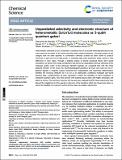Por favor, use este identificador para citar o enlazar a este item:
http://hdl.handle.net/10261/304253COMPARTIR / EXPORTAR:
 SHARE SHARE
 CORE
BASE CORE
BASE
|
|
| Visualizar otros formatos: MARC | Dublin Core | RDF | ORE | MODS | METS | DIDL | DATACITE | |

| Título: | Unparalleled selectivity and electronic structure of heterometallic [LnLn′Ln] molecules as 3-qubit quantum gates |
Autor: | Maniaki, Diamantoula; Garay-Ruiz, Diego; Barrios, L. A.; Martins, Daniel O. T. A.; Aguilà, David; Tuna, Floriana; Reta, Daniel; Roubeau, Olivier CSIC ORCID; Bo, Carles; Aromí, Guillem | Fecha de publicación: | 2022 | Editor: | Royal Society of Chemistry (UK) | Citación: | Chemical Science 13(19): 5574-5581 (2022) | Resumen: | Heterometallic lanthanide [LnLn′] coordination complexes that are accessible thermodynamically are very scarce because the metals of this series have very similar chemical behaviour. Trinuclear systems of this category have not been reported. A coordination chemistry scaffold has been shown to produce molecules of type [LnLn′Ln] of high purity, i.e. exhibiting high metal distribution ability, based on their differences in ionic radius. Through a detailed analysis of density functional theory (DFT) based calculations, we discern the energy contributions that lead to the unparalleled chemical selectivity of this molecular system. Some of the previously reported examples are compared here with the newly prepared member of this exotic list, [Er2Pr(LA)2(LB)2(py)(H2O)2](NO3) (1) (H2LA and H2LB are two β-diketone ligands). A magnetic analysis extracted from magnetization and calorimetry determinations identifies the necessary attributes for it to act as an addressable, conditional multiqubit spin-based quantum gate. Complementary ab initio calculations confirm the feasibility of these complexes as composite quantum gates, since they present well-isolated ground states with highly anisotropic and distinct g-tensors. The electronic structure of 1 has also been analyzed by EPR. Pulsed experiments have allowed the establishment of the quantum coherence of the transitions within the relevant spin states, as well as the feasibility of a coherent control of these states via nutation experiments. | Versión del editor: | https://doi.org/10.1039/D2SC00436D | URI: | http://hdl.handle.net/10261/304253 | DOI: | 10.1039/D2SC00436D | E-ISSN: | 2041-6539 |
| Aparece en las colecciones: | (INMA) Artículos (IQAC) Artículos (CIN2) Artículos |
Ficheros en este ítem:
| Fichero | Descripción | Tamaño | Formato | |
|---|---|---|---|---|
| unparalleled.pdf | 1,05 MB | Adobe PDF |  Visualizar/Abrir |
CORE Recommender
PubMed Central
Citations
3
checked on 08-abr-2024
WEB OF SCIENCETM
Citations
6
checked on 22-feb-2024
Page view(s)
45
checked on 30-abr-2024
Download(s)
19
checked on 30-abr-2024

